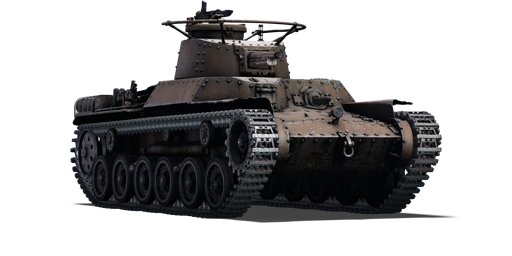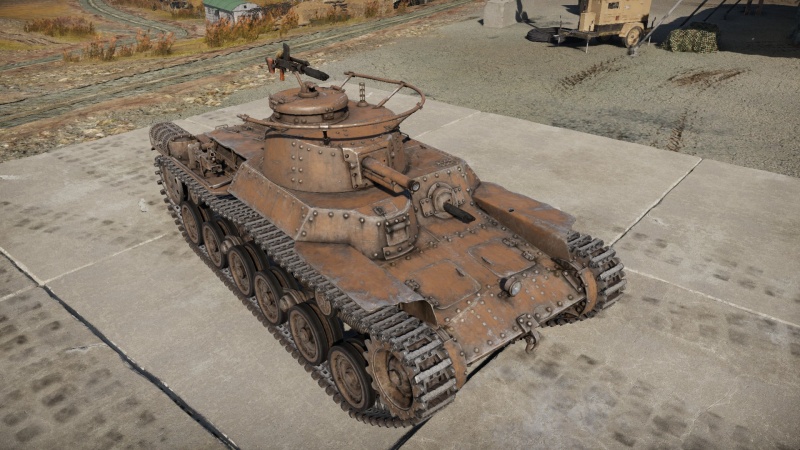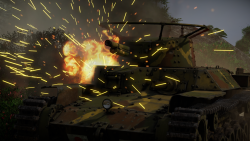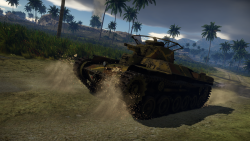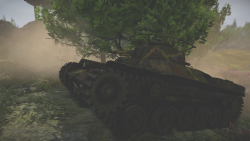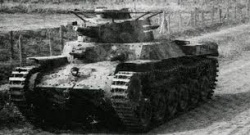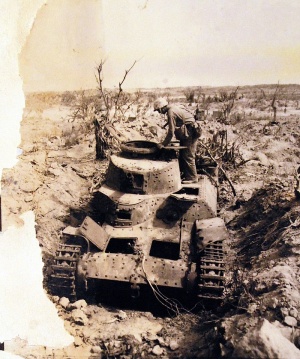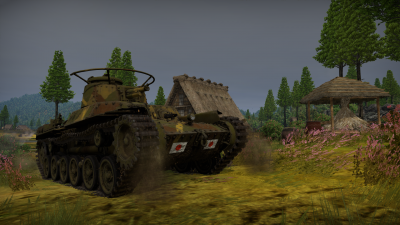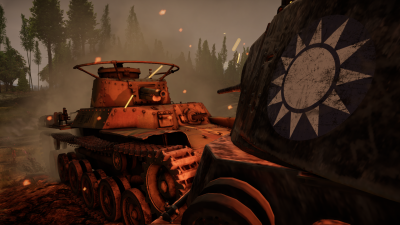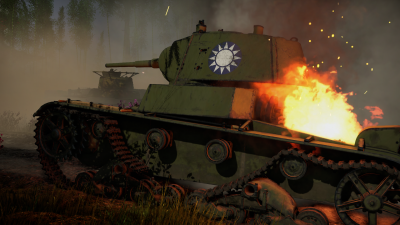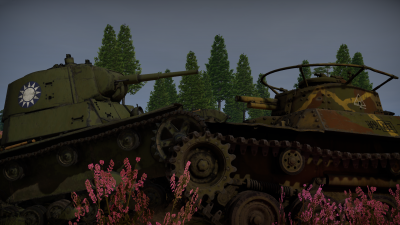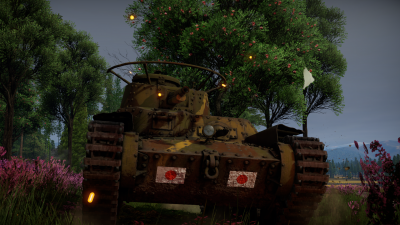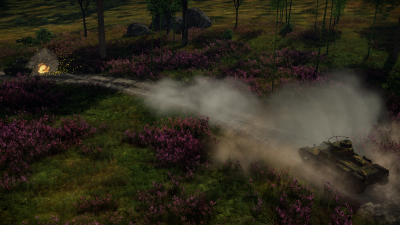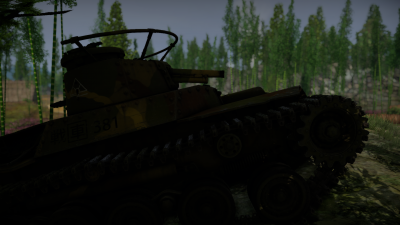Difference between revisions of "Chi-Ha"
m (Edits.) |
U143475368 (talk | contribs) (Updated the "Usage in Battles" and "Pros and Cons" sections.) (Tag: Visual edit) |
||
| (43 intermediate revisions by 11 users not shown) | |||
| Line 1: | Line 1: | ||
| − | |||
{{About | {{About | ||
| about = Japanese medium tank '''{{PAGENAME}}''' | | about = Japanese medium tank '''{{PAGENAME}}''' | ||
| − | | usage = other | + | | usage = other versions |
| link = Chi-Ha (Family) | | link = Chi-Ha (Family) | ||
| + | }} | ||
| + | {{Specs-Card | ||
| + | |code=jp_type_97_chi_ha | ||
| + | |images={{Specs-Card-Image|GarageImage_{{PAGENAME}}.jpg|ArtImage_{{PAGENAME}}.png}} | ||
}} | }} | ||
== Description == | == Description == | ||
| − | <!--''In the description, the first part | + | <!-- ''In the description, the first part should be about the history of the creation and combat usage of the vehicle, as well as its key features. In the second part, tell the reader about the ground vehicle in the game. Insert a screenshot of the vehicle, so that if the novice player does not remember the vehicle by name, he will immediately understand what kind of vehicle the article is talking about.'' --> |
| − | + | The '''{{Specs|name}}''' ({{Annotation|九七式中戦車「チハ」|Kyūnana Shiki Chū Sensha [Chi-Ha]}}) was developed to replace the [[I-Go Ko|Type 89 I-Go]] and essentially be a 4-man version of the [[Ha-Go|Type 95 Ha-Go]] as the 37 mm had little explosive power to deal with infantry. The Mitsubishi "Chi-Ha" competed with the cheaper design Osaka Arsenal "Chi-Ni", selected under the opportunity by the start of the Second Sino-Japanese War which increased the army's budget and left funds available for the more capable Type 97 Chi-Ha tank. Being the main medium tank of the Japanese after adoption, it would also serve as the main chassis for the army and variants. | |
| − | + | ||
| − | The '''{{Specs|name}}''' | + | It was introduced in [[Update 1.65 "Way of the Samurai"]] along with the initial Japanese vehicles of the Japanese Ground Forces Tree. Essentially a better armoured and engined [[I-Go Ko]], the Chi-Ha seems rather mediocre at first glance. However, this tank can perform quite well at its battle rating provided that it is played to its strengths, those being its decent mobility and low-velocity cannon with a relatively high penetrating HEAT shell that can be lobbed over cover. |
== General info == | == General info == | ||
| + | The Type 97 Chi-Ha is an upgraded version of the earlier Type 89 I-Go. The engine has been upgraded, from the Mitsubishi A6120VD air-cooled straight-six diesel with 120 hp to a Mitsubishi SA12200VD air-cooled V12 diesel with 170 hp. As such, the top speed has increased from 27 km/h on the I-Go to 38 km/h on the Chi-Ha. The armament stays the same, with the same shells and gun characteristics. The 5.7 cm Tank Gun Type 97 is robust, but will get the job done. It still has four crewmen inside, no armour, and a 7.7 mm Type 97 in the hull. Overall, it's in general a better I-Go. | ||
| + | |||
=== Survivability and armour === | === Survivability and armour === | ||
| − | <!--''Describe armour protection. Note the most well protected and key weak areas. Appreciate the layout of modules as well as the number and location of crew members. Is the level of armour protection sufficient, is the placement of modules | + | {{Specs-Tank-Armour}} |
| + | <!-- ''Describe armour protection. Note the most well protected and key weak areas. Appreciate the layout of modules as well as the number and location of crew members. Is the level of armour protection sufficient, is the placement of modules helpful for survival in combat? If necessary use a visual template to indicate the most secure and weak zones of the armour.'' --> | ||
| + | [[File:Chi-Ha (1).png|thumb|250px|Chi-Ha deflecting a shell to the driver port]] | ||
| + | Armour: Light, but effective against weaker guns (i.e. early French), weaker shells (low-caliber HE), and in long range engagements. | ||
| − | |||
'''Armour type:''' | '''Armour type:''' | ||
| Line 29: | Line 36: | ||
| Turret || 25 mm (9-41°) ''Turret front'' <br> 25 mm ''Gun mantlet'' || 25 mm (10-11°) || 25 mm (12°) || 10 mm | | Turret || 25 mm (9-41°) ''Turret front'' <br> 25 mm ''Gun mantlet'' || 25 mm (10-11°) || 25 mm (12°) || 10 mm | ||
|- | |- | ||
| − | + | | Cupola || colspan="3" style="text-align:center" | 17 mm || 6 mm | |
|- | |- | ||
| − | |||
|} | |} | ||
=== Mobility === | === Mobility === | ||
| − | <!--''Write about the mobility of the ground vehicle. Estimate the specific power and | + | {{Specs-Tank-Mobility}} |
| − | + | <!-- ''Write about the mobility of the ground vehicle. Estimate the specific power and manoeuvrability, as well as the maximum speed forwards and backwards.'' --> | |
| − | + | [[File:Chi-Ha (5).png|thumb|250px|Chi-Ha reaching its top speed of 44 km/h]] | |
| − | + | ||
| − | | | + | {{tankMobility|abMinHp=263|rbMinHp=150}} |
| − | + | {{Break}} | |
| − | + | ||
| − | + | === Modifications and economy === | |
| − | + | {{Specs-Economy}} | |
| − | | | ||
| − | |||
| − | |||
| − | |||
| − | |||
| − | |||
| − | |||
| − | |||
| − | |||
| − | |||
| − | |||
| − | |||
| − | |||
| − | |||
| − | |||
| − | |||
| − | |||
| − | |||
| − | |||
| − | |||
| − | |||
| − | |||
| − | |||
| − | |||
| − | |||
| − | |||
| − | |||
| − | |||
| − | |||
| − | |||
| − | |||
| − | |||
| − | |||
== Armaments == | == Armaments == | ||
| + | {{Specs-Tank-Armaments}} | ||
=== Main armament === | === Main armament === | ||
| − | <!--''Give the reader information about the characteristics of the main gun. Assess its effectiveness in a battle based on the reloading speed, ballistics and the power of shells. Do not forget about the | + | {{Specs-Tank-Weapon|1}} |
| + | <!-- ''Give the reader information about the characteristics of the main gun. Assess its effectiveness in a battle based on the reloading speed, ballistics and the power of shells. Do not forget about the flexibility of the fire, that is how quickly the cannon can be aimed at the target, open fire on it and aim at another enemy. Add a link to the main article on the gun: <code><nowiki>{{main|Name of the weapon}}</nowiki></code>. Describe in general terms the ammunition available for the main gun. Give advice on how to use them and how to fill the ammunition storage.'' --> | ||
| + | [[File:Chi-Ha (2).png|thumb|250px|Chi-Ha being able to depress at -15°]] | ||
{{main|Type 97 (57 mm)}} | {{main|Type 97 (57 mm)}} | ||
| − | {| class="wikitable" style="text-align:center | + | The gun is the same as on the I-Go. Not much to write home about, but we're hardly complaining, especially with the HEAT shell. |
| − | + | ||
| − | + | {| class="wikitable" style="text-align:center" width="100%" | |
| − | |||
| − | |||
| − | |||
| − | |||
| − | |||
| − | |||
| − | |||
| − | |||
| − | |||
| − | |||
| − | |||
| − | |||
| − | |||
| − | |||
| − | |||
| − | |||
| − | |||
| − | |||
|- | |- | ||
| − | | | + | ! colspan="5" | [[Type 97 (57 mm)|57 mm Type 97]] || colspan="5" | Turret rotation speed (°/s) || colspan="4" | Reloading rate (seconds) |
|- | |- | ||
| − | ! | + | ! Mode !! Capacity !! Vertical !! Horizontal !! Stabilizer |
| + | ! Stock !! Upgraded !! Full !! Expert !! Aced | ||
| + | ! Stock !! Full !! Expert !! Aced | ||
|- | |- | ||
| − | ! | + | ! ''Arcade'' |
| − | + | | rowspan="2" | 120 || rowspan="2" | -15°/+20° || rowspan="2" | ±180° || rowspan="2" | {{Annotation|Shoulder|up to 10 km/h}} || 14.5 || 20.0 || 24.3 || 26.9 || 28.6 || rowspan="2" | 4.29 || rowspan="2" | 3.80 || rowspan="2" | 3.50 || rowspan="2" | 3.30 | |
| − | |||
| − | |||
|- | |- | ||
| − | | | + | ! ''Realistic'' |
| + | | 9.0 || 10.6 || 12.9 || 14.3 || 15.2 | ||
|- | |- | ||
|} | |} | ||
| − | + | ==== Ammunition ==== | |
| − | { | + | {{:Type 97 (57 mm)/Ammunition|Type 92 APHE, Type 3 HEAT}} |
| − | + | ||
| − | + | ==== [[Ammo racks]] ==== | |
| − | + | [[File:Ammoracks_{{PAGENAME}}.png|right|thumb|x250px|[[Ammo racks]] of the {{PAGENAME}}]] | |
| − | + | <!-- '''Last updated: 2.15.1.70''' --> | |
| − | + | {| class="wikitable" style="text-align:center" | |
| − | |||
| − | |||
| − | |||
| − | |||
| − | |||
| − | |||
| − | |||
| − | |||
| − | | Type 92 APHE | ||
| − | |||
| − | |||
| − | |||
| − | |||
| − | |||
| − | |||
| − | |||
| − | |||
| − | |||
| − | |||
| − | ! | ||
| − | |||
| − | '' | ||
| − | |||
| − | |||
| − | |||
| − | |||
| − | |||
| − | |||
| − | |||
| − | |||
| − | |||
|- | |- | ||
| − | + | ! Full<br>ammo | |
| + | ! 1st<br>rack empty | ||
| + | ! 2nd<br>rack empty | ||
| + | ! 3rd<br>rack empty | ||
| + | ! 4th<br>rack empty | ||
| + | ! 5th<br>rack empty | ||
| + | ! Visual<br>discrepancy | ||
|- | |- | ||
| − | | | + | | '''120''' || 116 ''(+4)'' || 112 ''(+8)'' || 88 ''(+32)'' || 68 ''(+52)'' || 0 ''(+120)'' || No |
|- | |- | ||
|} | |} | ||
| + | '''Note:''' | ||
| − | + | * Right side only: 68 ''(+52)'' shells. | |
| − | |||
| − | |||
| − | |||
| − | |||
| − | |||
| − | |||
| − | |||
| − | |||
| − | |||
| − | |||
| − | |||
| − | |||
| − | |||
| − | |||
| − | |||
| − | Right side only: | ||
=== Machine guns === | === Machine guns === | ||
| − | <!--''Offensive and anti-aircraft machine guns not only allow you to fight some aircraft | + | {{Specs-Tank-Weapon|2}} |
| − | {{main|Type 97 | + | {{Specs-Tank-Weapon|3}} |
| + | <!-- ''Offensive and anti-aircraft machine guns not only allow you to fight some aircraft but also are effective against lightly armoured vehicles. Evaluate machine guns and give recommendations on its use.'' --> | ||
| + | {{main|Type 97 (7.7 mm)}} | ||
| − | {| class="wikitable" style="text-align:center" | + | {| class="wikitable" style="text-align:center" width="50%" |
|- | |- | ||
| − | ! colspan=" | + | ! colspan="5" | [[Type 97 (7.7 mm)|7.7 mm Type 97]] |
|- | |- | ||
| − | ! | + | ! Mount !! Capacity (Belt) !! Fire rate !! Vertical !! Horizontal |
|- | |- | ||
| − | + | | Hull || 3,000 (20) || 499 || ±10° || ±15° | |
| − | |||
| − | |||
| − | |||
|- | |- | ||
| − | | | + | | Pintle || 1,000 (20) || 499 || 0°/+60° || -80°/+10° |
|- | |- | ||
|} | |} | ||
| − | == Usage in | + | == Usage in battles == |
| − | <!--''Describe the tactics of playing in the vehicle, the features of using vehicles in the team and advice on tactics. Refrain from creating a "guide" - do not impose a single point of view but give the reader food for thought. Describe the most dangerous enemies and give recommendations on fighting them. If necessary, note the specifics of the game in different modes (AB, RB, SB).''--> | + | <!-- ''Describe the tactics of playing in the vehicle, the features of using vehicles in the team and advice on tactics. Refrain from creating a "guide" - do not impose a single point of view but instead give the reader food for thought. Describe the most dangerous enemies and give recommendations on fighting them. If necessary, note the specifics of the game in different modes (AB, RB, SB).'' --> |
| − | The Chi-Ha is the most interesting tank to play | + | [[File:Chi-Ha (3).png|left|thumb|250px|The Chi-Ha passing a disabled Chinese [[T-26 (China)|T-26]]]] |
| + | The Chi-Ha is the most interesting Rank I Japanese tank to play as it has little to no armour, a shot-put-like muzzle velocity and looks like a bus in some sense as to how long it is. But there is a way to play this tank despite all the negatives to this tank and to play it to the best of its abilities, one can play it as a support tank in every way (apart from long distance as the rounds drop like a brick after 500 m). Stay close to teammates and always play sneaky as the Chi-Ha can be easily taken out with a single shot by any opponent, like all Japanese tanks in this rank. | ||
| + | [[File:Chi-Ha (4).png|thumb|250px|The Chi-Ha destroying another [[T-26]]]] | ||
| + | But when facing a heavy tank or early Rank II medium tank, issues can arise. These can be very hard to engage head-on and the fact that the APHE rounds severely lack penetration doesn't help. So the best option is to go up behind it or attack from the side to destroy them. Another problem that shows itself strongly in close quarter fights is that the Chi-Ha has a hand-cranked turret and turning the tank is painful at best. So it is best to plan ahead before attacking, think where the enemy may be and find a place to hide the bulky tank from the enemy and wait for the enemy to come to the firing range. The Type 3 HEAT shell changes this: with 55 mm of penetration, the tank is now capable of penetrating tanks that it previously couldn't - those being most tanks at Ranks I and II. In addition to this, the HEAT shell has the potential to overpressure lightly armoured targets like [[LVT (Family)|LVTs]] or the [[15cm sIG 33 B Sfl|Sturmpanzer]]. Use the protection analysis feature to figure out which tanks you can and can't get through, and adapt your playstyle accordingly when those vehicles are encountered. Now, this is somewhat important: "'''Don't''' look for the enemy, let the '''enemy''' look for the Chi-Ha." Of course, the Chi-Ha could still go look for the enemy, but always be on alert and make sure to have a friend for firing support. | ||
| − | + | The engine is not that powerful, which then means that initial acceleration will be slow, but it will slowly get faster over time. Reversing, however is comparable to most British tanks: it's going to be slow. But this is compensated by the turning speed of this tank, so it is better to turn and run than reverse in some cases. | |
| − | + | === Pros and cons === | |
| + | <!-- ''Summarise and briefly evaluate the vehicle in terms of its characteristics and combat effectiveness. Mark its pros and cons in a bulleted list. Try not to use more than 6 points for each of the characteristics. Avoid using categorical definitions such as "bad", "good" and the like - use substitutions with softer forms such as "inadequate" and "effective".'' --> | ||
| − | |||
| − | |||
'''Pros:''' | '''Pros:''' | ||
* Improved sloped armour compared to the reserve vehicles | * Improved sloped armour compared to the reserve vehicles | ||
| − | * Quite fast (up to 44 km/h) | + | * Quite fast (up to 44 km/h), allowing it to get to certain spots in time |
| − | * Lovely climbing ability | + | * Lovely climbing ability combined with the amazing -15 degrees gun depression, it is great at mountain combat |
| − | * Due to | + | * Has a vertical stabiliser which most tanks don't have, allowing the Chi-Ha to get the first shot off |
| + | * Due to the low shell velocity, can shoot behind cover without showing the tank to some degree | ||
| + | * Effective HEAT shell, can frontally penetrate common targets like [[Pz.III (Family)|Pz. IIIs]], and destroy lighter tanks like [[LVT (Family)|LVTs]] with overpressure | ||
| + | * Great turning ability in low gear | ||
'''Cons:''' | '''Cons:''' | ||
| − | * | + | * Main armament may be inadequate in an uptier, especially in frontal engagements |
| − | * Thin armour that can be penetrated by | + | * Thin armour that can be penetrated by 20 mms /.50 cals up close |
| − | * Abysmal penetration | + | * Abysmal penetration on stock APHE, will struggle to penetrate most low tier tanks like [[M3 Stuart (Family)|Stuarts]] and [[T-70|T-70s]] |
== History == | == History == | ||
| − | <!--''Describe the history of the creation and combat usage of the | + | <!-- ''Describe the history of the creation and combat usage of the vehicle in more detail than in the introduction. If the historical reference turns out to be too long, take it to a separate article, taking a link to the article about the vehicle and adding a block "/History" (example: <nowiki>https://wiki.warthunder.com/(Vehicle-name)/History</nowiki>) and add a link to it here using the <code>main</code> template. Be sure to reference text and sources by using <code><nowiki><ref></ref></nowiki></code>, as well as adding them at the end of the article with <code><nowiki><references /></nowiki></code>. This section may also include the vehicle's dev blog entry (if applicable) and the in-game encyclopedia description (under <code><nowiki>=== In-game description ===</nowiki></code>, also if applicable).'' --> |
| + | {{main|Chi-Ha (Family)|l1=History of the Type 97 Chi-Ha}} | ||
| + | |||
===Development=== | ===Development=== | ||
| + | [[File:Solo Chi-Ha.jpg|alt=Singular Chi-Ha driving on the road|thumb|250px]] | ||
The Imperial Japanese Army's main tank was the [[I-Go Ko|Type 89]], adopted in 1929, but it was deemed obsolete as of 1935 and the IJA wanted something up to par with their battle style. The Type 89's main fault was its low overall road speed, which was unable to keep up with motorized infantry. Thus, the development of a new medium tank commenced with the goal of improved overall speed, low weight, and low cost.<ref name="ZalogaJapaneseTank">Zaloga Steven. ''Japanese Tanks 1939-1945'' Great Britain: Osprey Publishing Ltd., 2007</ref> | The Imperial Japanese Army's main tank was the [[I-Go Ko|Type 89]], adopted in 1929, but it was deemed obsolete as of 1935 and the IJA wanted something up to par with their battle style. The Type 89's main fault was its low overall road speed, which was unable to keep up with motorized infantry. Thus, the development of a new medium tank commenced with the goal of improved overall speed, low weight, and low cost.<ref name="ZalogaJapaneseTank">Zaloga Steven. ''Japanese Tanks 1939-1945'' Great Britain: Osprey Publishing Ltd., 2007</ref> | ||
| Line 236: | Line 162: | ||
===Combat usage=== | ===Combat usage=== | ||
| + | [[File:Chi-Ha Bukit Timah.jpg|left|thumb|250px|Japanese troops during the battle of Bukit Timah, Battle of Singapore]] | ||
The Type 97 Chi-Ha would first see its main usage in the border conflict against the Soviet forces in the Battles of Khalkin-Gol. In the Japanese 1st Tank Group's total 85 tanks, there were four Type 97 mediums present in comparison to the 34 Type 89 I-Go, 35 [[Ha-Go|Type 95 Ha-Go]] lights, and 13 tankettes.<ref name="ZalogaChiHavsSherman">Zaloga Steven. ''M4 Sherman vs Type 97 Chi-Ha: The Pacific 1945'' Great Britain: Osprey Publishing Ltd., 2012</ref> Though the armoured units played a critical role in Japan's offensive against the Soviet Union, they were soon demolished by the Soviet armoured brigades, leading to their recall. The Japanese defeat at Khalkin-Gol did teach them a few lessons, first in that they were currently under-equipped for a fight against a large European force, which led to an enlargement of the Japanese armoured forces. Second was that the Japanese tanks were unsuitable for tank-to-tank fighting as the Soviet's main tank armament, the 45 mm cannon, was way more suitable than anything the Japanese had. This led to the development of a new anti-tank gun and tank gun for the Japanese Army, the Type 1 47 mm, though this would not see service until 1941.<ref name="ZalogaJapaneseTank" /> | The Type 97 Chi-Ha would first see its main usage in the border conflict against the Soviet forces in the Battles of Khalkin-Gol. In the Japanese 1st Tank Group's total 85 tanks, there were four Type 97 mediums present in comparison to the 34 Type 89 I-Go, 35 [[Ha-Go|Type 95 Ha-Go]] lights, and 13 tankettes.<ref name="ZalogaChiHavsSherman">Zaloga Steven. ''M4 Sherman vs Type 97 Chi-Ha: The Pacific 1945'' Great Britain: Osprey Publishing Ltd., 2012</ref> Though the armoured units played a critical role in Japan's offensive against the Soviet Union, they were soon demolished by the Soviet armoured brigades, leading to their recall. The Japanese defeat at Khalkin-Gol did teach them a few lessons, first in that they were currently under-equipped for a fight against a large European force, which led to an enlargement of the Japanese armoured forces. Second was that the Japanese tanks were unsuitable for tank-to-tank fighting as the Soviet's main tank armament, the 45 mm cannon, was way more suitable than anything the Japanese had. This led to the development of a new anti-tank gun and tank gun for the Japanese Army, the Type 1 47 mm, though this would not see service until 1941.<ref name="ZalogaJapaneseTank" /> | ||
| − | + | [[File:Chi-Ha Destroyed.jpg|alt=Knocked out entrenched Chi-Ha at Iwo Jima|thumb|Knocked out, entrenched Chi-Ha at Iwo Jima]] | |
The next major usage of the Type 97 would be in Japan's conflict during World War II against the Allies. The Type 97 made up a good portion of the Japanese armoured forces when they invaded the Malay peninsula of British territory in Operation Centrifuge<ref name="ZalogaChiHavsSherman">Zaloga Steven. ''M4 Sherman vs Type 97 Chi-Ha: The Pacific 1945'' Great Britain: Osprey Publishing Ltd., 2012</ref>. The Japanese tank's successes against Britain is attributed to the British belief that the terrain around Singapore made it very hard to use armoured forces, thus there was a lack of Allied armour available in the battle. In a span of three months, Japan managed to completely overcome the defenses of the Malay peninsula and the Allied forces there surrendered. The Burma campaign soon followed, but the fighting there would last most of the war's time.<ref name="ZalogaJapaneseTank" /> | The next major usage of the Type 97 would be in Japan's conflict during World War II against the Allies. The Type 97 made up a good portion of the Japanese armoured forces when they invaded the Malay peninsula of British territory in Operation Centrifuge<ref name="ZalogaChiHavsSherman">Zaloga Steven. ''M4 Sherman vs Type 97 Chi-Ha: The Pacific 1945'' Great Britain: Osprey Publishing Ltd., 2012</ref>. The Japanese tank's successes against Britain is attributed to the British belief that the terrain around Singapore made it very hard to use armoured forces, thus there was a lack of Allied armour available in the battle. In a span of three months, Japan managed to completely overcome the defenses of the Malay peninsula and the Allied forces there surrendered. The Burma campaign soon followed, but the fighting there would last most of the war's time.<ref name="ZalogaJapaneseTank" /> | ||
Japan then invaded the Americans in the Philippines. It was here that the Japanese armoured forces baptized the American tankers in their first tank-to-tank combat with [[M3 Stuart|M3 Stuarts]] against Type 95 Ha-Go. It was during this campaign that Colonel Seinosuke Sonoda of the 7th Tank Regiment advocated for the placement of the new Type 1 47 mm gun as the main armament of the Type 97 Chi-Ha. This would lead to the development and production of the next generation Type 97s, the [[Chi-Ha Kai|Type 97-''Kai'' (Improved) ''Shinhoto'' (New turret) Chi-Ha]], which would eventually encompass the regular Type 97's production. Though now surpassed by the Type 97 Chi-Ha Kai, the regular Type 97 would still see usage alongside its improved variant in the Pacific campaign against the Allies. | Japan then invaded the Americans in the Philippines. It was here that the Japanese armoured forces baptized the American tankers in their first tank-to-tank combat with [[M3 Stuart|M3 Stuarts]] against Type 95 Ha-Go. It was during this campaign that Colonel Seinosuke Sonoda of the 7th Tank Regiment advocated for the placement of the new Type 1 47 mm gun as the main armament of the Type 97 Chi-Ha. This would lead to the development and production of the next generation Type 97s, the [[Chi-Ha Kai|Type 97-''Kai'' (Improved) ''Shinhoto'' (New turret) Chi-Ha]], which would eventually encompass the regular Type 97's production. Though now surpassed by the Type 97 Chi-Ha Kai, the regular Type 97 would still see usage alongside its improved variant in the Pacific campaign against the Allies. | ||
| + | {{Break}} | ||
== Media == | == Media == | ||
| − | '' | + | <!-- ''Excellent additions to the article would be video guides, screenshots from the game, and photos.'' --> |
| + | {{main|Chi-Ha (Family)#Media|l1=Media of the Type 97 Chi-Ha family}} | ||
| + | |||
| + | ;Skins | ||
| + | |||
| + | * [https://live.warthunder.com/feed/camouflages/?vehicle=jp_type_97_chi_ha Skins and camouflages for the {{PAGENAME}} from live.warthunder.com.] | ||
| + | {{Skin-gallery | ||
| + | |market|ugcitem_1000602|Type-97 Chi-Ha of the 9th Sensha Rentai.png|Camo "9th Sensha Rentai" | ||
| + | |market|Type 97 Chi-Ha Ichi-Hai № 381|Type 97 Chi-Ha Ichi-Hai.jpg|Camo "Ichi-Hai № 381" | ||
| + | }} | ||
| + | |||
| + | ;Images | ||
| + | <gallery mode="packed-hover" heights="150px"> | ||
| + | Chi-Ha (12).png| | ||
| + | Chi-Ha (9).png| | ||
| + | Chi-Ha (8).png| | ||
| + | Chi-Ha (10).png| | ||
| + | Chi-Ha (7).png| | ||
| + | Chi-Ha (11).png| | ||
| + | Chi-Ha (13).png| | ||
| + | Chi-Ha (14).png| | ||
| + | </gallery> | ||
| − | + | ;Videos | |
| − | + | {{Youtube-gallery|4_cJ1CpEatw|'''Best gun depression''' discusses the {{PAGENAME}} at 1:33 - ''War Thunder Official Channel''}} | |
| − | == | + | == See also == |
| − | <!--''Links to the articles on the War Thunder Wiki that you think will be useful for the reader, for example | + | <!-- ''Links to the articles on the War Thunder Wiki that you think will be useful for the reader, for example:'' |
* ''reference to the series of the vehicles;'' | * ''reference to the series of the vehicles;'' | ||
| − | * ''links to approximate analogues of other nations and research trees | + | * ''links to approximate analogues of other nations and research trees.'' --> |
| − | |||
| − | |||
| − | + | ;Related Development | |
| − | |||
| + | * [[Chi-Ha (Family)]] | ||
| + | * [[Ho-I]] | ||
| + | |||
| + | == External links == | ||
| + | <!-- ''Paste links to sources and external resources, such as:'' | ||
* ''topic on the official game forum;'' | * ''topic on the official game forum;'' | ||
| − | * ''other literature.'' | + | * ''other literature.'' --> |
| + | |||
| + | * [[wt:en/news/4330-development-type-97-chi-ha-hope-of-the-army-en/|[Devblog] Type 97 Chi-Ha: Hope of the Army]] | ||
| + | |||
| + | ===References=== | ||
| + | <references /> | ||
| + | {{TankManufacturer Mitsubishi}} | ||
{{Japan medium tanks}} | {{Japan medium tanks}} | ||
Latest revision as of 19:41, 2 July 2024
| This page is about the Japanese medium tank Chi-Ha. For other versions, see Chi-Ha (Family). |
Contents
Description
The Type 97 Chi-Ha (九七式中戦車「チハ」) was developed to replace the Type 89 I-Go and essentially be a 4-man version of the Type 95 Ha-Go as the 37 mm had little explosive power to deal with infantry. The Mitsubishi "Chi-Ha" competed with the cheaper design Osaka Arsenal "Chi-Ni", selected under the opportunity by the start of the Second Sino-Japanese War which increased the army's budget and left funds available for the more capable Type 97 Chi-Ha tank. Being the main medium tank of the Japanese after adoption, it would also serve as the main chassis for the army and variants.
It was introduced in Update 1.65 "Way of the Samurai" along with the initial Japanese vehicles of the Japanese Ground Forces Tree. Essentially a better armoured and engined I-Go Ko, the Chi-Ha seems rather mediocre at first glance. However, this tank can perform quite well at its battle rating provided that it is played to its strengths, those being its decent mobility and low-velocity cannon with a relatively high penetrating HEAT shell that can be lobbed over cover.
General info
The Type 97 Chi-Ha is an upgraded version of the earlier Type 89 I-Go. The engine has been upgraded, from the Mitsubishi A6120VD air-cooled straight-six diesel with 120 hp to a Mitsubishi SA12200VD air-cooled V12 diesel with 170 hp. As such, the top speed has increased from 27 km/h on the I-Go to 38 km/h on the Chi-Ha. The armament stays the same, with the same shells and gun characteristics. The 5.7 cm Tank Gun Type 97 is robust, but will get the job done. It still has four crewmen inside, no armour, and a 7.7 mm Type 97 in the hull. Overall, it's in general a better I-Go.
Survivability and armour
Armour: Light, but effective against weaker guns (i.e. early French), weaker shells (low-caliber HE), and in long range engagements.
Armour type:
- Rolled homogeneous armour
| Armour | Front | Sides | Rear | Roof |
|---|---|---|---|---|
| Hull | 25 mm (12-32°) Front plate 17 mm (63-81°) Front glacis 15 mm (37-59°) Lower glacis |
25 mm (40°) Top Left 25 mm (25-27°) Top Right 20 mm Bottom |
20 mm (4-58°) | 12 mm |
| Turret | 25 mm (9-41°) Turret front 25 mm Gun mantlet |
25 mm (10-11°) | 25 mm (12°) | 10 mm |
| Cupola | 17 mm | 6 mm | ||
Mobility
| Game Mode | Max Speed (km/h) | Weight (tons) | Engine power (horsepower) | Power-to-weight ratio (hp/ton) | |||
|---|---|---|---|---|---|---|---|
| Forward | Reverse | Stock | Upgraded | Stock | Upgraded | ||
| Arcade | Expression error: Unexpected * operator. | 263 | Expression error: Unexpected round operator. | __.__ | |||
| Realistic | 150 | Expression error: Unexpected round operator. | __.__ | ||||
Modifications and economy
Armaments
Main armament
The gun is the same as on the I-Go. Not much to write home about, but we're hardly complaining, especially with the HEAT shell.
| 57 mm Type 97 | Turret rotation speed (°/s) | Reloading rate (seconds) | |||||||||||
|---|---|---|---|---|---|---|---|---|---|---|---|---|---|
| Mode | Capacity | Vertical | Horizontal | Stabilizer | Stock | Upgraded | Full | Expert | Aced | Stock | Full | Expert | Aced |
| Arcade | 120 | -15°/+20° | ±180° | Shoulder | 14.5 | 20.0 | 24.3 | 26.9 | 28.6 | 4.29 | 3.80 | 3.50 | 3.30 |
| Realistic | 9.0 | 10.6 | 12.9 | 14.3 | 15.2 | ||||||||
Ammunition
| Penetration statistics | |||||||
|---|---|---|---|---|---|---|---|
| Ammunition | Type of warhead |
Penetration @ 0° Angle of Attack (mm) | |||||
| 10 m | 100 m | 500 m | 1,000 m | 1,500 m | 2,000 m | ||
| Type 92 APHE | APHE | 21 | 21 | 19 | 16 | 14 | 13 |
| Type 3 HEAT | HEAT | 55 | 55 | 55 | 55 | 55 | 55 |
| Shell details | ||||||||||||
|---|---|---|---|---|---|---|---|---|---|---|---|---|
| Ammunition | Type of warhead |
Velocity (m/s) |
Projectile mass (kg) |
Fuse delay (m) |
Fuse sensitivity (mm) |
Explosive mass (TNT equivalent) (g) |
Ricochet | |||||
| 0% | 50% | 100% | ||||||||||
| Type 92 APHE | APHE | 349 | 2.58 | 1.2 | 9 | 103 | 47° | 60° | 65° | |||
| Type 3 HEAT | HEAT | 380 | 1.8 | 0.05 | 0.1 | 303.36 | 62° | 69° | 73° | |||
Ammo racks
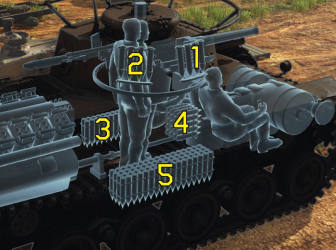
| Full ammo |
1st rack empty |
2nd rack empty |
3rd rack empty |
4th rack empty |
5th rack empty |
Visual discrepancy |
|---|---|---|---|---|---|---|
| 120 | 116 (+4) | 112 (+8) | 88 (+32) | 68 (+52) | 0 (+120) | No |
Note:
- Right side only: 68 (+52) shells.
Machine guns
| 7.7 mm Type 97 | ||||
|---|---|---|---|---|
| Mount | Capacity (Belt) | Fire rate | Vertical | Horizontal |
| Hull | 3,000 (20) | 499 | ±10° | ±15° |
| Pintle | 1,000 (20) | 499 | 0°/+60° | -80°/+10° |
Usage in battles
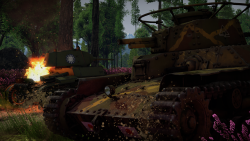
The Chi-Ha is the most interesting Rank I Japanese tank to play as it has little to no armour, a shot-put-like muzzle velocity and looks like a bus in some sense as to how long it is. But there is a way to play this tank despite all the negatives to this tank and to play it to the best of its abilities, one can play it as a support tank in every way (apart from long distance as the rounds drop like a brick after 500 m). Stay close to teammates and always play sneaky as the Chi-Ha can be easily taken out with a single shot by any opponent, like all Japanese tanks in this rank.

But when facing a heavy tank or early Rank II medium tank, issues can arise. These can be very hard to engage head-on and the fact that the APHE rounds severely lack penetration doesn't help. So the best option is to go up behind it or attack from the side to destroy them. Another problem that shows itself strongly in close quarter fights is that the Chi-Ha has a hand-cranked turret and turning the tank is painful at best. So it is best to plan ahead before attacking, think where the enemy may be and find a place to hide the bulky tank from the enemy and wait for the enemy to come to the firing range. The Type 3 HEAT shell changes this: with 55 mm of penetration, the tank is now capable of penetrating tanks that it previously couldn't - those being most tanks at Ranks I and II. In addition to this, the HEAT shell has the potential to overpressure lightly armoured targets like LVTs or the Sturmpanzer. Use the protection analysis feature to figure out which tanks you can and can't get through, and adapt your playstyle accordingly when those vehicles are encountered. Now, this is somewhat important: "Don't look for the enemy, let the enemy look for the Chi-Ha." Of course, the Chi-Ha could still go look for the enemy, but always be on alert and make sure to have a friend for firing support.
The engine is not that powerful, which then means that initial acceleration will be slow, but it will slowly get faster over time. Reversing, however is comparable to most British tanks: it's going to be slow. But this is compensated by the turning speed of this tank, so it is better to turn and run than reverse in some cases.
Pros and cons
Pros:
- Improved sloped armour compared to the reserve vehicles
- Quite fast (up to 44 km/h), allowing it to get to certain spots in time
- Lovely climbing ability combined with the amazing -15 degrees gun depression, it is great at mountain combat
- Has a vertical stabiliser which most tanks don't have, allowing the Chi-Ha to get the first shot off
- Due to the low shell velocity, can shoot behind cover without showing the tank to some degree
- Effective HEAT shell, can frontally penetrate common targets like Pz. IIIs, and destroy lighter tanks like LVTs with overpressure
- Great turning ability in low gear
Cons:
- Main armament may be inadequate in an uptier, especially in frontal engagements
- Thin armour that can be penetrated by 20 mms /.50 cals up close
- Abysmal penetration on stock APHE, will struggle to penetrate most low tier tanks like Stuarts and T-70s
History
Development
The Imperial Japanese Army's main tank was the Type 89, adopted in 1929, but it was deemed obsolete as of 1935 and the IJA wanted something up to par with their battle style. The Type 89's main fault was its low overall road speed, which was unable to keep up with motorized infantry. Thus, the development of a new medium tank commenced with the goal of improved overall speed, low weight, and low cost.[1]
Two tank designs were developed with these specifications, both were produced by Mitsubishi. The first was the Chi-Ha which was powered by a 170hp diesel engine. The second was Chi-Ni, which was lighter, cheaper, and powered by a 135 hp diesel engine. The IJA chose at the time of 1937, when war with China broke out to the Second Sino-Japanese War. This war increased the IJA's budget and thus they decided to pick the better of the two design. This led to the finalization of the Type 97 Chi-Ha tank. Production started in 1938 all the way to 1942 for a total of 1162 tanks produced.[1][2]
Design
The Type 97 Chi-Ha was a medium tank constructed with rivets in the armour plates. It had a crew of four with a two-men turret. The turret held the same low-velocity 57 mm gun from the Type 89. Armour was relatively thin, but quite standard at the time of 1930s, but this would become very vulnerable past 1941 when the Japanese war expands to the world.[1]
The Type 97 Chi-Ha, like the standard tanks of other countries, was used in a multitude of roles by adapting its chassis to another purpose such as the Ho-Ni assault gun series. The Type 97 Chi-Ha design was also improved upon multiple times with better armour and better guns, resulting in tanks like the Shinhoto Chi-Ha, Type 1 Chi-He, Type 2 Ho-I, and the Type 3 Chi-Nu.[1]
Combat usage
The Type 97 Chi-Ha would first see its main usage in the border conflict against the Soviet forces in the Battles of Khalkin-Gol. In the Japanese 1st Tank Group's total 85 tanks, there were four Type 97 mediums present in comparison to the 34 Type 89 I-Go, 35 Type 95 Ha-Go lights, and 13 tankettes.[2] Though the armoured units played a critical role in Japan's offensive against the Soviet Union, they were soon demolished by the Soviet armoured brigades, leading to their recall. The Japanese defeat at Khalkin-Gol did teach them a few lessons, first in that they were currently under-equipped for a fight against a large European force, which led to an enlargement of the Japanese armoured forces. Second was that the Japanese tanks were unsuitable for tank-to-tank fighting as the Soviet's main tank armament, the 45 mm cannon, was way more suitable than anything the Japanese had. This led to the development of a new anti-tank gun and tank gun for the Japanese Army, the Type 1 47 mm, though this would not see service until 1941.[1]
The next major usage of the Type 97 would be in Japan's conflict during World War II against the Allies. The Type 97 made up a good portion of the Japanese armoured forces when they invaded the Malay peninsula of British territory in Operation Centrifuge[2]. The Japanese tank's successes against Britain is attributed to the British belief that the terrain around Singapore made it very hard to use armoured forces, thus there was a lack of Allied armour available in the battle. In a span of three months, Japan managed to completely overcome the defenses of the Malay peninsula and the Allied forces there surrendered. The Burma campaign soon followed, but the fighting there would last most of the war's time.[1]
Japan then invaded the Americans in the Philippines. It was here that the Japanese armoured forces baptized the American tankers in their first tank-to-tank combat with M3 Stuarts against Type 95 Ha-Go. It was during this campaign that Colonel Seinosuke Sonoda of the 7th Tank Regiment advocated for the placement of the new Type 1 47 mm gun as the main armament of the Type 97 Chi-Ha. This would lead to the development and production of the next generation Type 97s, the Type 97-Kai (Improved) Shinhoto (New turret) Chi-Ha, which would eventually encompass the regular Type 97's production. Though now surpassed by the Type 97 Chi-Ha Kai, the regular Type 97 would still see usage alongside its improved variant in the Pacific campaign against the Allies.
Media
- Skins


- Images
- Videos
See also
- Related Development
External links
References
| Mitsubishi Heavy Industries (三菱重工業株式会社) | |
|---|---|
| Light Tanks | |
| Type 95 | Ha-Go · Ha-Go Commander |
| Medium Tanks | |
| Type 89 | I-Go Ko |
| Type 97 | Chi-Ha · Chi-Ha Kai |
| Type 1 | Chi-He · Chi-He (5th Regiment) |
| Type 3 | Chi-Nu · Chi-Nu II |
| Type 4 | Chi-To · Chi-To Late |
| Type 5 | Chi-Ri II |
| SPGs | |
| Chi-Ha Derived | Ho-Ro |
| Chi-He Derived | Ho-I |
| Chi-Ri Derived | Ho-Ri Prototype · Ho-Ri Production |
| Other | Na-To · Ro-Go Exp. |
| Captured | ␗Chi-Ha · ␗Chi-Ha Kai |
| Note | Most tank designs would be contracted by the Army Technical Bureau to Mitsubishi |
| See also | Mitsubishi Heavy Industries Ltd. (Post-War) |
| Japan medium tanks | |
|---|---|
| Type 97 | Chi-Ha · Chi-Ha Kai · Chi-Ha Kai TD · Chi-Ha Short Gun |
| Type 1 | Chi-He · Chi-He (5th Regiment) · Ho-I |
| Type 3 | Chi-Nu · Chi-Nu II |
| Type 4 | Chi-To · Chi-To Late |
| Type 5 | Chi-Ri II |
| Type 61 MBT | ST-A1* · ST-A2* · ST-A3* · Type 61 |
| Type 74 MBT | ST-B2* · Type 74 (C) · Type 74 (E) · Type 74 (F) · Type 74 (G) |
| Type 90 MBT | Type 90 · Type 90 (B) · Type 90 (B) "Fuji" |
| Type 10 MBT | TKX (P)* · TKX* · Type 10 |
| Other | Ka-Chi |
| USA | ▅M4A3 (76) W · ▅M47 |
| *Prototype | |


